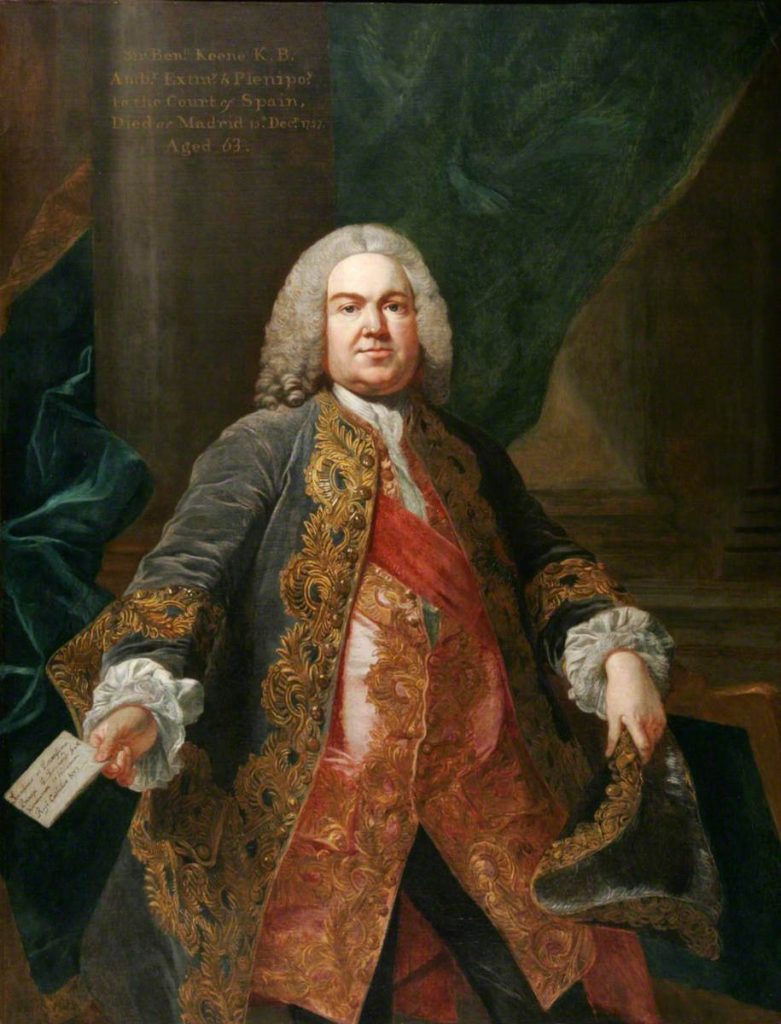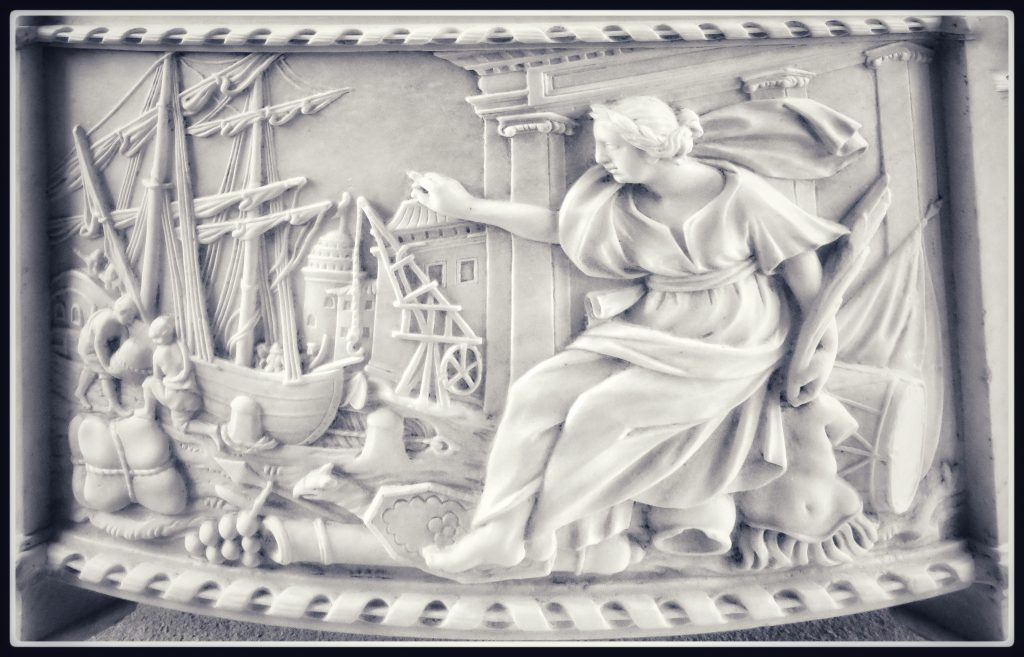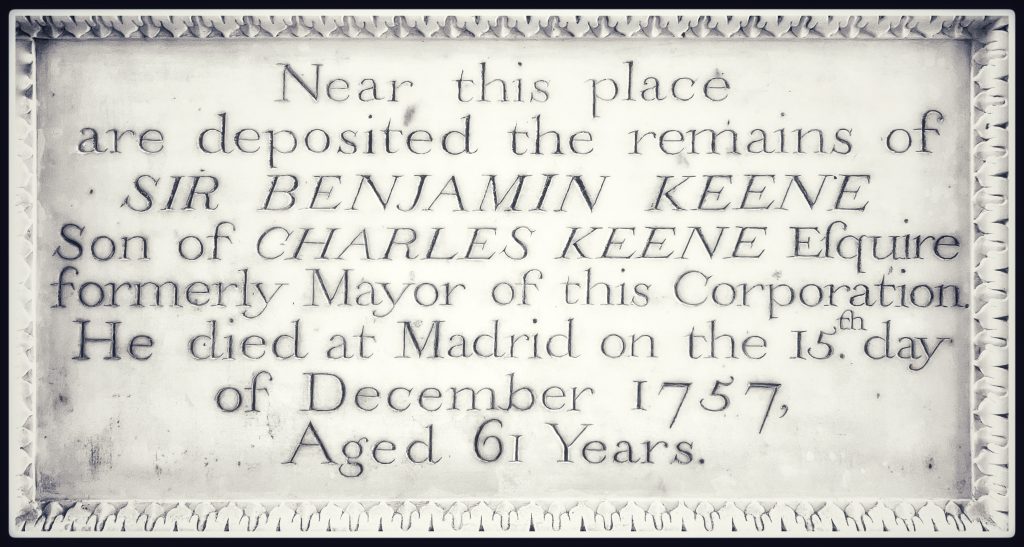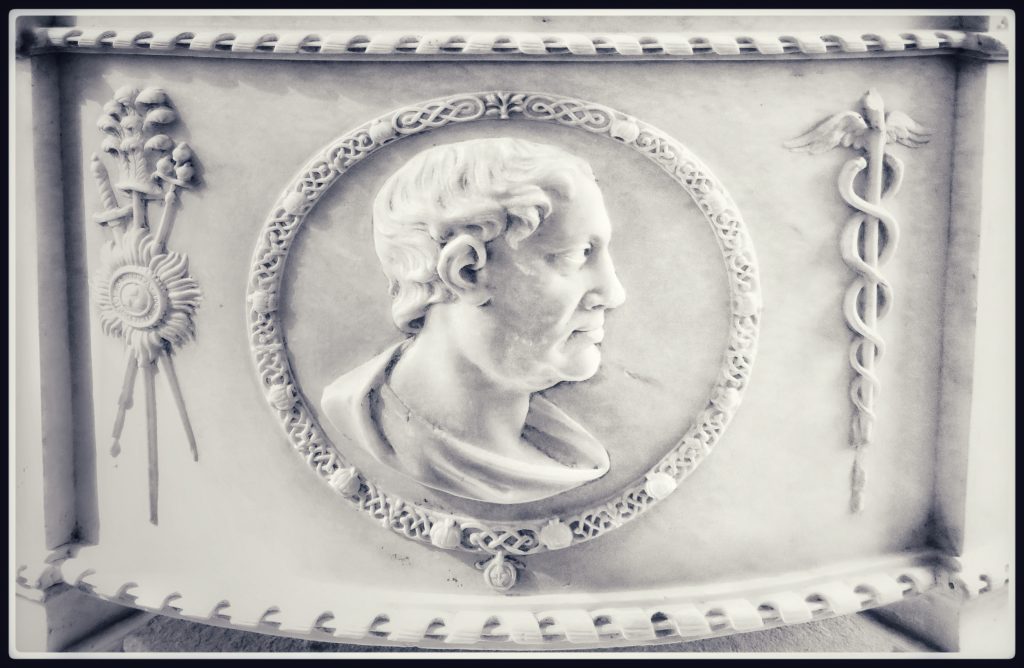King’s Lynn man goes to Spain and helps save thousands of lives
Sir Benjamin Keene 1697 – 1757
Introduction
At various stages in his life Sir Benjamin Keene had been an MP, a Paymaster General for Pensions, and Ambassador to Portugal and then to Spain. I prefer to think of him as the local lad who made it onto the national and international stage, who arguably contributed to the saving of many lives, and who allegedly brought Lisbon to King’s Lynn.

King’s Lynn Town Hall
His story is interesting, and in some ways gruesome. It involves a pickled ear and a heartless body. (If you are of a nervous disposition, look away now.)
Early Life
They say that in order to rise to the very top of any profession you need three things: a good deal of luck, a small degree of talent, and a sponsor (someone who will help open doors for you in high places). Well, Sir Benjamin Keene had all three of these things.
Benjamin had a lucky birth. In 1697 he was born into a family that had wealth, status, and influence. By around 1700 the Keene family household and commercial premises were located in what is now Old School Court in King Street, King’s Lynn. His mother, Susan Rolfe, came from a rich and powerful land-owning family in Heacham; his father was a timber merchant. His father Charles, his uncle Benjamin, and his grandfather Edmund all served as Mayors of Lynn.
Benjamin had luck, and he had talent. He studied at the local free grammar school when it was in the Charnel Chapel attached to St Margaret’s church. By the time Benjamin’s father’s business had begun to decline forcing them to leave the Old School Court site in 1721, Benjamin himself had already left the nest and had gone on to study law at the universities of Cambridge and then Leiden.
Benjamin had luck, he had talent, and he had sponsors. Edmund Rolfe (his maternal grandfather) was also the election agent for Sir Robert Walpole. It was this crucial connection that helped his career.
When Walpole was in the process of building a network of loyal men from west Norfolk to serve as his eyes and ears throughout Europe, the legal abilities of a known local lad were very useful. Family connections brought him to the notice of Viscount Townshend who sent him to Madrid in 1723, as an agent of the South Sea Company. He later becomes a Consul for the government.
A Diplomat in Difficult Times
In order to appreciate what Keene achieved in his life you need to briefly understand two important things about the C18th.
The first is that it was a century of trade expansion. Up until the C18th most of our trade had been with Europe, but during this century we were trying to establish trading dominance, not only in India, but in the Americas as well. So were many of our trading rivals.
The second is that it was a century of war. Britain was fighting almost constantly from 1690’s through to 1815. Protestant Britain was constantly worried what the other two big players, Catholic France and Catholic Spain, were going to do.
It was a challenging time to be a British diplomat. But Keene was fluent in both Spanish and Portuguese and had learned how the Spanish and Portuguese Courts and their various systems of royal etiquette functioned. He has been described as the most significant statesman in Anglo-Spanish relations in eighteenth century.
Summary of His Achievements
One writer has conjectured that Keene was able to give Walpole advice on Spanish Rioja and Sherry. After all, we know that Walpole was buying 1000 bottles of wine at a time from Lynn merchants for Houghton Hall. However, we have more certainty about his other actions. Let me summarise his four main achievements for you:
His first major achievement
He successfully negotiated The Treaty of Seville in 1729 which ended the two year Anglo-Spanish war and saved many lives. (Stanhope got credit for it back in England.)
His second major achievement
In 1739 he successfully negotiated the Peace Convention of Prado with Spain (a commitment not to go to war).
In 1731 a British sea captain, Robert Jenkins had his ship in the West Indies boarded by Spanish coast guards looking for contraband. Things got a bit tense, and in the ensuing melee, a coastguard chopped off Captain Jenkins’ left ear.
Eight years later, Parliament summonsed Captain Jenkins and his pickled ear to appear and tell the story. Opposition politicians were hoping to cause an outrage against Spain because they believed that a victorious war would increase trade in the Caribbean.
But Benjamin tried to keep Britain out of the war which went on for another nine years.
In 1739 he was forced back to England as an MP (for Maldon in Essex and then for Looe in Cornwall) but his letters show that he disliked being in parliament, especially when the warmongers didn’t appreciate his diplomatic efforts. He was nicknamed “Don Benjamin” by his enemies because of his Spanish sympathies, and at one stage he feared impeachment. In his letters he says he was “not made for party squabbles” and found domestic politics petty. He loved Spain and Portugal. He adored their food and wine and was knowledgeable about Spanish literature. He longed to get back overseas.
In 1745 he is sent to Portugal and spends three very happy years in Lisbon trying to negotiate peace with Spain.
Keene never married, but we know that while in Lisbon he had a very close relationship with a merchant called Abraham Castris, with whom he shared a house.
His third major achievement
In 1748 he goes back to Spain and in the next few years is involved in negotiating various commercial and peace treaties with France, Spain, Austria, and Sardina.
His fourth major achievement
Perhaps his greatest achievement was in the years before his death.
While in Madrid Benjamin could sense another war coming (The Seven Years War – 1756-63 – designated by some historians as the ‘real’ First World War). The main adviser to the Spanish King, Esanada, was pro-French and anti-British. Keene used his friendship with King Ferdinand VI and his diplomatic skill to bring about the downfall of Esanada and help keep Spain out of the war against Britain for six of the seven years. This arguably contributed to the saving countless thousands of lives. (Imagine how many lives would have been saved in Britain hadn’t entered the First World War until 1917.)
He Returns to King’s Lynn
In 1754 Benjamin’s achievements were recognised when George II awarded him the Order of the Bath. (This was unusual for someone coming from Keene’s social background.) He was so highly regarded in Spain that the award was presented to him personally by Ferdinand VI, King of Spain.

Photo © James Rye 2022
In the summer of 1757 Keene was very ill, and wished to retire from his post, but was persuaded by Pitt and the King to remain in post. He died at Madrid on 15 December 1757.
His remains were brought to Deal on 29 March 1758, and he now has a magnificent marble funeral urn in the St. Nicholas Chapel in King’s Lynn. The urn was designed by Robert Adam and was paid for by public subscription in 1762. The urn depicts the Goddess of Peace sitting on the ruins of war in Lisbon harbour. Keene had three very happy years as Ambassador to Portugal and spent his working life trying to keep Britain and Spain from going to war.
Some people get very interested in what the urn might contain and argue that it is too small to have a body. They hypothesise that it might be Keene’s ashes or claim that his body was disposed of in Madrid and that only his heart returned to England.

Photo © James Rye 2022
The reality is that the urn almost certainly contains nothing. The inscription says that the remains are deposited “near this place”, and “this place” has changed. In 1895 the urn was moved to its present position from where it had been previously in the vestry or sacristy over the Keene burial vault. What precisely is buried in that vault, nobody knows – though perhaps one day someone will solve the mystery.
Keene helped a merchant who became the governor of New Hampshire. In appreciation the governor named a rebuilt New Hampshire town after him in 1753 (although there has been at least one recent press letter demanding that the town be renamed). He has an urn in King’s Lynn. A local school has a house named after him and the town he also has a Keene Road. In my view he certainly deserves a King’s Lynn town plaque.
Sir Benjamin Keene, the local lad who did good, who hit the national and international stage, who was inevitably touched by the asiento, who couldn’t quite avoid the pickled ear, but who arguably contributed to the saving of many lives, and who allegedly brought Lisbon to Lynn.

Photo © James Rye 2022
© James Rye 2021
Sources
- Colley, L. (1997) Norfolk, Britain, and Spain – the career of Sir Benjamin Keene, K.B., Lecture arranged by the King’s Lynn Society of Arts and Sciences for the King’s Lynn Festival
- Hillen, H.J. (1907) History of the Borough of King’s Lynn, Vol.2, EP Publishing Ltd.
- Langford, P. (2002) The Eighteenth Century, Oxford University Press
- Lodge, R. (ed.) (1933) The private correspondence of Sir Benjamin Keene, K. B., Cambridge University Press
- Richards, W. (1812). The History of Lynn: Civil, Ecclesiastical, Political, Commercial, Biographical, Municipal, and Military, from the Earliest Accounts to the Present Time, W. G. Whittingham
- Various (2017) St Nicholas Chapel, King’s Lynn: Discover More, The Churches Conservation Trust
Websites:
- American Historical Review – https://academic.oup.com/ahr/article/120/2/433/45569
- British History Online – https://www.british-history.ac.uk/hist-mss-comm/vol11/pt3/pp185-209
- Canceling History – Let’s Look into this Benjamin Keene – https://www.sentinelsource.com/opinion/editorial/canceling-history-removing-names-is-too-simplistic-an-answer-to-past-racism-or-other-misdeeds/article_7447b4bc-6cc2-5e80-8790-f5a14b364024.html
- Dictionary of National Biography – https://en.wikisource.org/wiki/Dictionary_of_National_Biography,_1885-1900/Keene,_Benjamin
- Infogalactic – http://www.infogalactic.com/info/Benjamin_Keene
- Keene New Hampshire – http://freepages.rootsweb.com/~vcgreene/genealogy/art%20keene%202.html
- KL Magazine – https://www.klmagazine.co.uk/articles/on-his-majesty-s-not-so-secret-service
- Maritime Memorials M6012 – https://memorials.rmg.co.uk/m6012/
- Spectator Archive – http://archive.spectator.co.uk/article/21st-april-1933/21/a-georgian-diplomat
- The South Sea Company and Slave Trade – https://curiosity.lib.harvard.edu/south-sea-bubble/feature/the-south-sea-company-and-the-slave-trade
- Wiki 2 – https://wiki2.org/en/Benjamin_Keene
- Wikipedia – https://en.wikipedia.org/wiki/Treaty_of_Madrid_(5_October_1750)

[…] Read more about Sir Benjamin Keene. […]
[…] of the most striking memorials is the one dedicated to Sir Benjamin Keene, designed by the esteemed neo-classical architect Robert Adam. Keen’s family lived on the […]